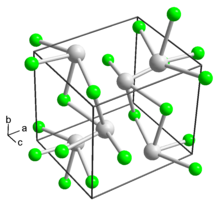Thallium(I) fluoride

| |
| Names | |
|---|---|
| Preferred IUPAC name
Thallium(I) fluoride | |
| Other names
Thallium monofluoride
Thallous fluoride | |
| Identifiers | |
3D model (JSmol)
|
|
| ChemSpider | |
| ECHA InfoCard | 100.029.231 |
| EC Number |
|
PubChem CID
|
|
| RTECS number |
|
| UNII | |
CompTox Dashboard (EPA)
|
|
| |
| |
| Properties | |
| TlF | |
| Molar mass | 223.3817 g/mol |
| Appearance | White crystals |
| Density | 8.36 g cm−3 |
| Melting point | 327 °C (621 °F; 600 K) |
| Boiling point | 655 °C (1,211 °F; 928 K) (decomposes) |
| 78.6 g/100 mL (at 15 °C)[1] | |
| Solubility | slightly soluble in ethanol |
| −44.4·10−6 cm3/mol | |
| Structure | |
| Orthorhombic, oP8 | |
| Fmmm, No. 28 | |
| Hazards[2] | |
| GHS labelling: | |
  
| |
| Danger | |
| H300, H330, H373, H411 | |
| P260, P264, P270, P271, P273, P284, P301+P310, P304+P340, P310, P314, P320, P321, P330, P391, P403+P233, P405, P501 | |
| Related compounds | |
Other anions
|
Thallium(I) chloride |
Other cations
|
Gallium(III) fluoride |
Except where otherwise noted, data are given for materials in their standard state (at 25 °C [77 °F], 100 kPa).
| |
Thallium(I) fluoride is the inorganic compound with the formula TlF. It is a white solid, forming orthorhombic crystals. The solid is slightly deliquescent.[1] It has a distorted sodium chloride (rock salt) crystal structure,[3][4] due to the 6s2 inert pair on Tl+.[5]
This salt is unusual among the thallium(I) halides in that it is very soluble in water.[6]
Reactions
[edit]Thallium(I) fluoride can be prepared by the reaction of thallium(I) carbonate with hydrofluoric acid.[3]
References
[edit]- ^ a b Perry, Dale L.; Phillips, Sidney L. (1995), Handbook of Inorganic Compounds, CRC Press, p. 407, ISBN 0-8493-8671-3, retrieved 2008-06-17
- ^ "399833 Thallium(I) fluoride 99%". Sigma-Aldrich. Retrieved 2008-06-17.
- ^ a b Wiberg, Nils; Wiberg, Egon; Holleman, A. F. (2001), Inorganic Chemistry, Academic Press, p. 1037, ISBN 0-12-352651-5, retrieved 2008-06-17
- ^ Meyer, Gerd; Naumann, Dieter; Wesemann, Lars (2006), Inorganic Chemistry in Focus III, Wiley-VCH, p. 21, ISBN 3-527-31510-1, retrieved 2008-06-17
- ^ Berastegui, P.; Hull, S. (2000). "The Crystal Structures of Thallium(I) Fluoride". Journal of Solid State Chemistry. 150 (2): 266. Bibcode:2000JSSCh.150..266B. doi:10.1006/jssc.1999.8587.
- ^ Arora, M. G. (2003), P-block Elements, Anmol Publications, p. 35, ISBN 81-7488-563-3, retrieved 2008-06-17
| Neg. ox. states | |||
|---|---|---|---|
| Thallium(I) |
| ||
| Thallium(III) | |||
Text is available under the CC BY-SA 4.0 license; additional terms may apply.
Images, videos and audio are available under their respective licenses.
